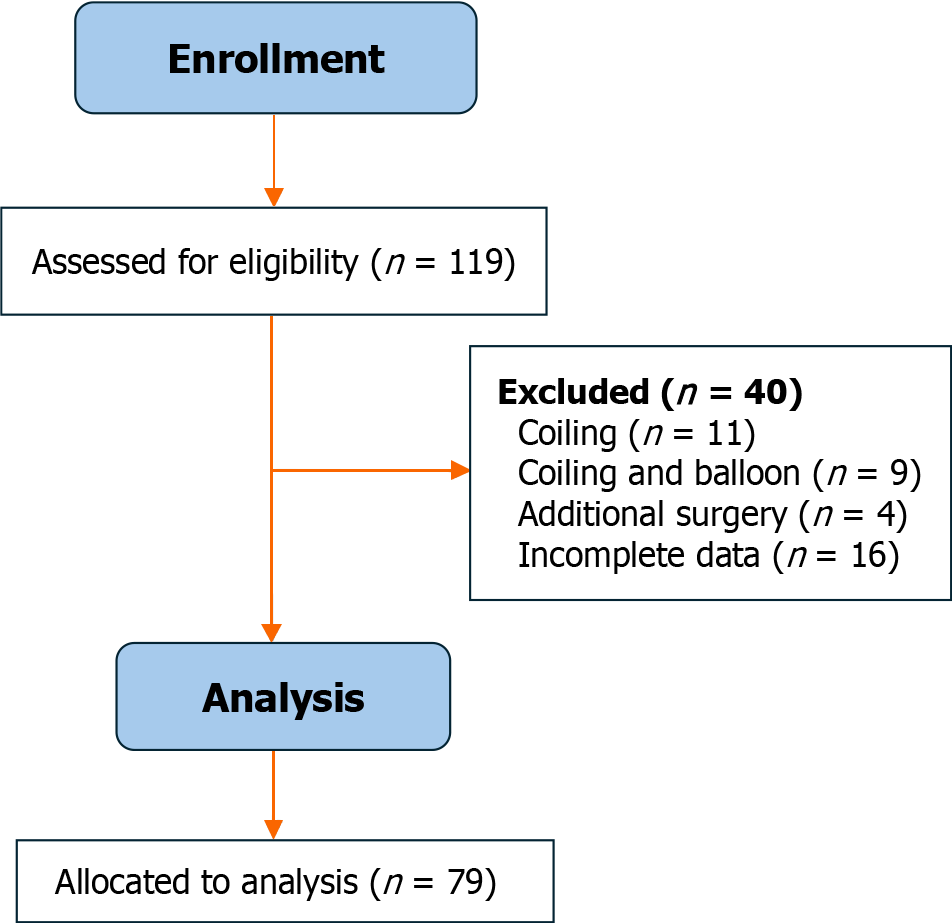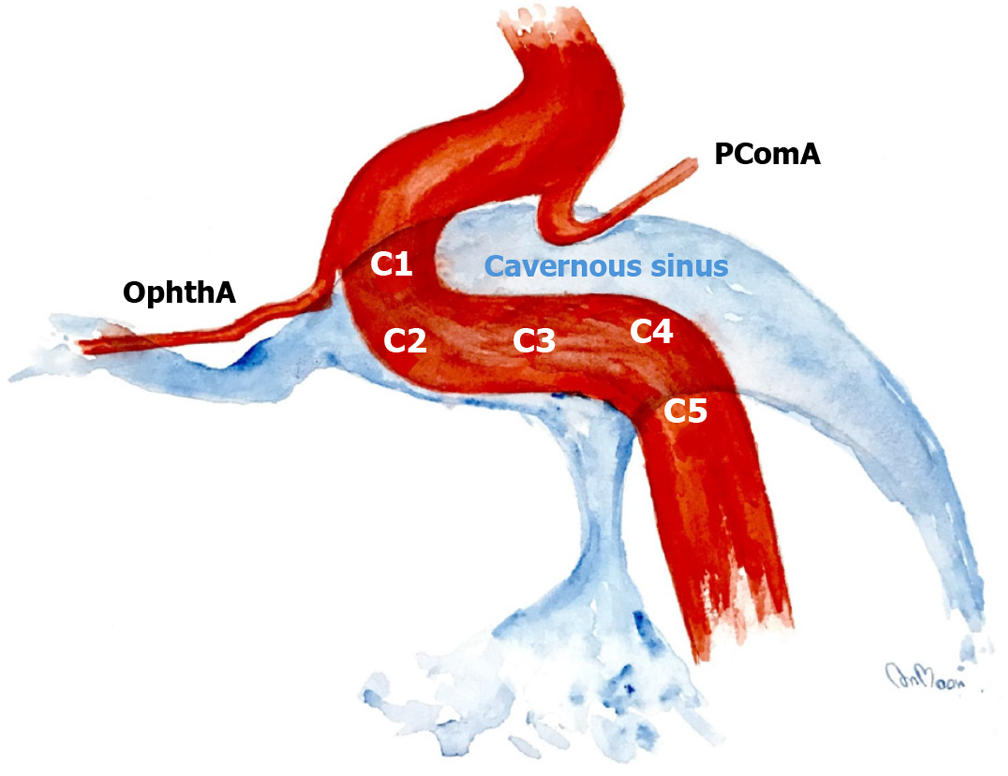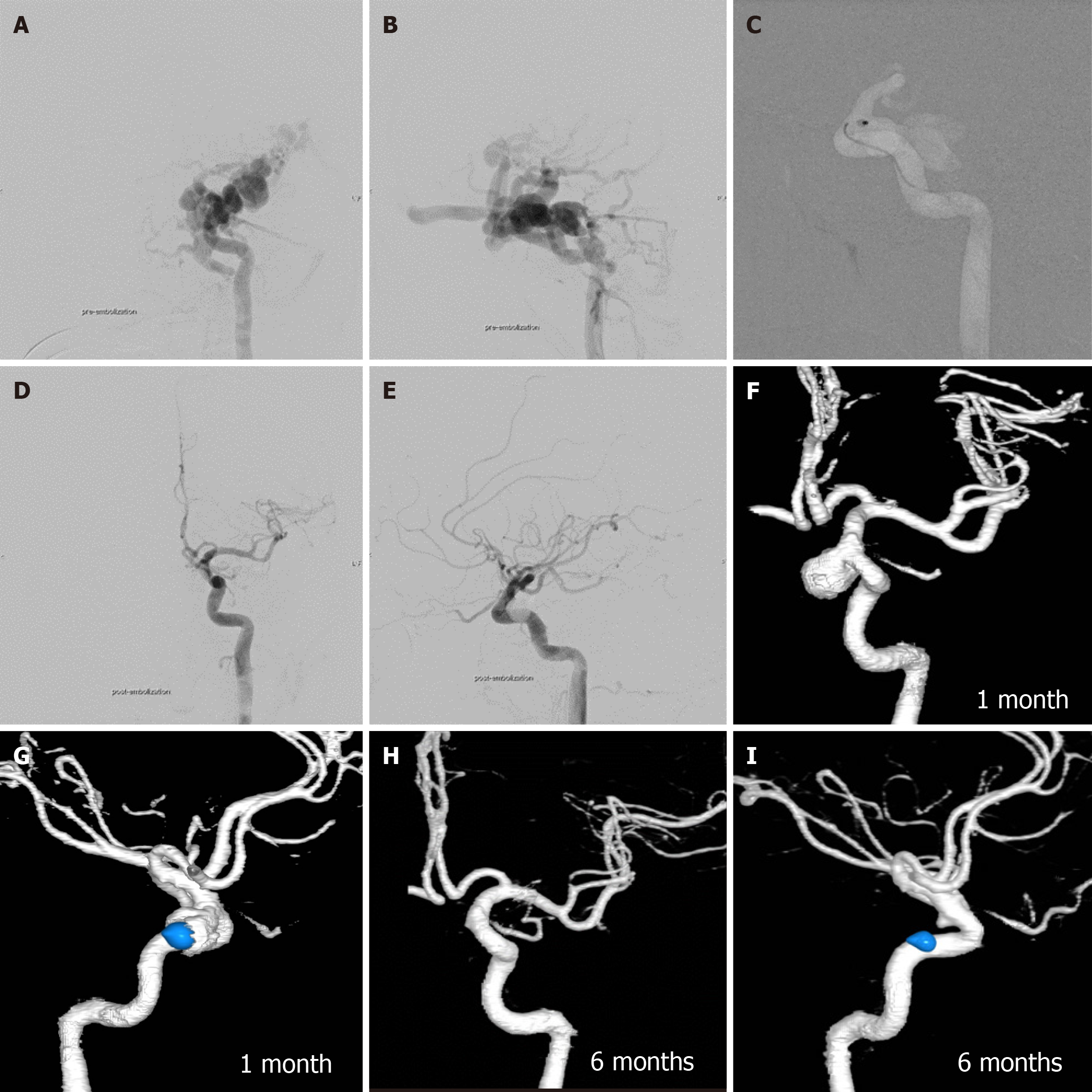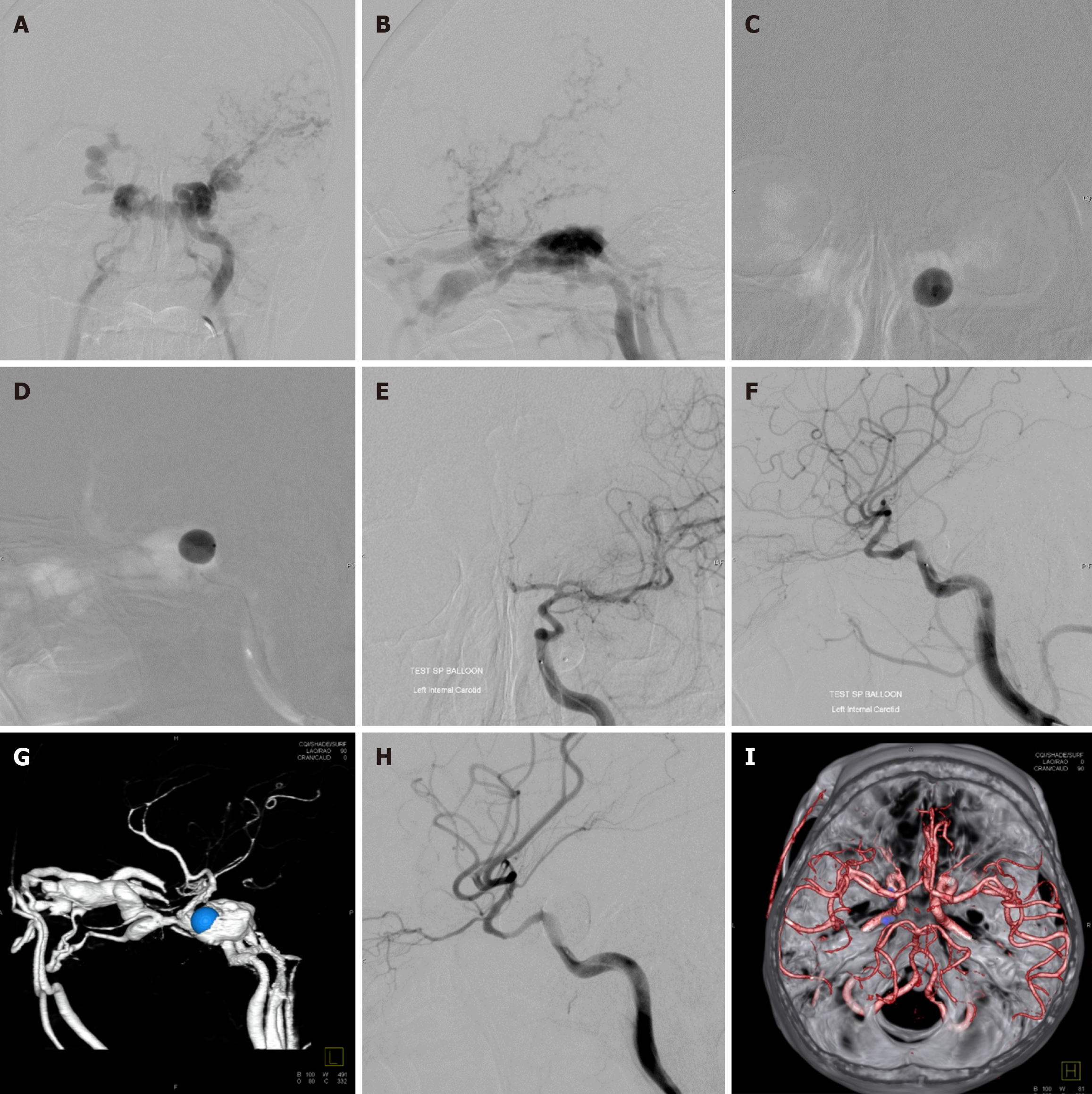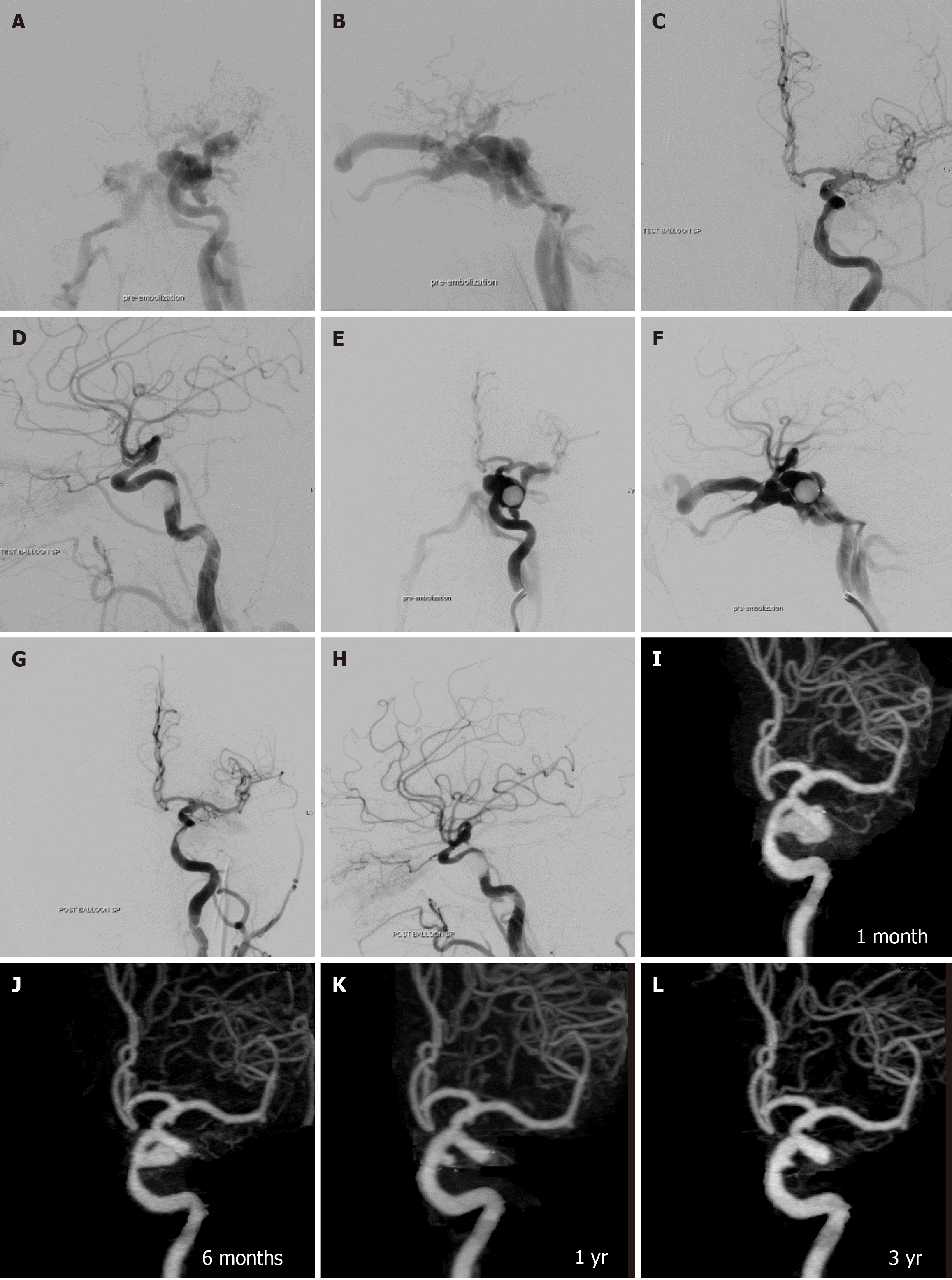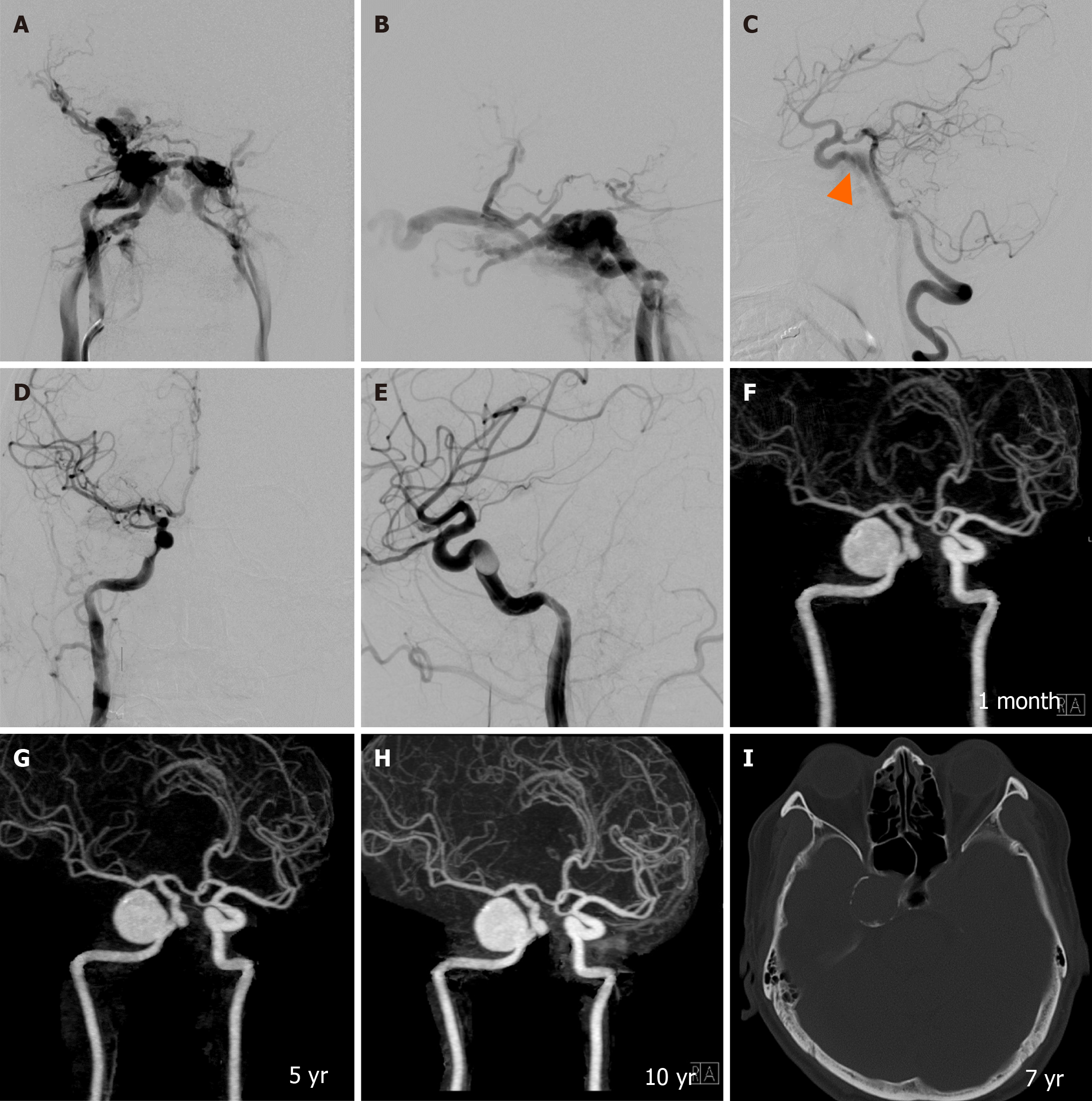Copyright
©The Author(s) 2024.
World J Radiol. Apr 28, 2024; 16(4): 94-108
Published online Apr 28, 2024. doi: 10.4329/wjr.v16.i4.94
Published online Apr 28, 2024. doi: 10.4329/wjr.v16.i4.94
Figure 1 Flow chart of the study.
Figure 2 Location of the fistula.
Schematic diagram illustrating the segments of the cavernous internal carotid artery, which is divided into five segments including: C1, anterior ascending segment; C2, junction between the anterior ascending and horizontal segment; C3, horizontal segment; C4, junction between the horizontal and posterior ascending segment; and C5, posterior ascending segment. OphthA: Ophthalmic artery; PComA: Posterior communicating artery.
Figure 3 Classification of traumatic carotid-cavernous fistulas according to the fistula size.
A and B: Anteroposterior (AP) and lateral views of a small-sized fistula, which had good antegrade ipsilateral internal carotid artery (ICA) flow, represented by opacification of both the anterior cerebral artery (ACA) and middle cerebral artery (MCA); C and D: AP and lateral views of a medium-sized fistula, which had fair antegrade flow, represented by opacification of either the ACA or MCA; E and F: AP and lateral views of a large-sized fistula, which had poor antegrade flow, represented by opacification of neither the ACA nor MCA.
Figure 4 A 22-year-old male presented with left proptosis and red eye after a motor vehicle accident 3 years prior.
A and B: Anteroposterior (AP) and lateral views of the left internal carotid artery (LICA) injection showed large traumatic carotid-cavernous fistula without antegrade flow into anterior and middle cerebral arteries; C: Lateral view of the LICA demonstrated a detachable balloon navigating into the orifice of the fistula at the C1 cavernous segment of the LICA under road-mapping; D and E: AP and lateral views of the LICA injection revealed complete obliteration of the fistula after the detachment of the balloon; F and G: AP and lateral views of three-dimensional reconstructed images of the LICA using computed tomography angiography (CTA) obtained 1 month after embolization showed a large pseudoaneurysm (grade 3); H and I: The same projection of the three-dimensional reconstructed images of the LICA using CTA obtained 6 months after embolization demonstrated a minimal residual pseudoaneurysm (grade 1).
Figure 5 A 40-year-old male presented with left proptosis and audible bruit after a motor vehicle accident 4 months prior.
A and B: Anteroposterior (AP) and lateral views of the left internal carotid artery (LICA) injection showed large traumatic carotid-cavernous fistula without antegrade flow into the anterior and middle cerebral arteries; C and D: AP and lateral views of the LICA demonstrated a detachable balloon during inflation at the left posterior cavernous sinus under road-mapping; E and F: AP and lateral views of the LICA injection revealed complete obliteration of the fistula; G: Lateral view of three-dimensional reconstructed images of the LICA using computed tomography angiography (CTA) of the LICA obtained 3 d after embolization showed recurrent traumatic carotid-cavernous fistula with displacement of a balloon into the anterior cavernous sinus; H: Lateral view of the LICA injection revealed complete obliteration of the fistula after retreatment with another balloon; I: Three-dimensional reconstructed image of both ICAs, vertebrobasilar system, and skull base using CTA obtained 6 months after embolization confirmed no residual pseudoaneurysm (grade 0).
Figure 6 A 27-year-old male presented with left proptosis and red eye immediately after a motor vehicle accident.
A and B: Anteroposterior (AP) and lateral views of the left internal carotid artery (LICA) injection showed large traumatic carotid-cavernous fistula without antegrade flow into the anterior and middle cerebral arteries; C and D: AP and lateral views of the LICA revealed complete obliteration of the fistula after the detachment of the balloon; E and F: AP and lateral views of the LICA obtained 1 wk later demonstrated recurrent traumatic carotid-cavernous fistula; G and H: AP and lateral views of the LICA confirmed complete obliteration after retreatment with balloon embolization; I-L: AP views of the three-dimensional reconstructed images of the LICA using computed tomography angiography at 1 month (I), 6 months (J), 1 year (K), and 3 years (L) on the same projection demonstrated the regression of pseudoaneurysm at C5 cavernous segment of the LICA from large (grade 3) to small (grade 1) size.
Figure 7 A 30-year-old male presented with right proptosis and red eye 1 d following a motor vehicle accident.
A and B: Anteroposterior (AP) and lateral views of the right internal carotid artery (RICA) injection showed large traumatic carotid-cavernous fistula without antegrade flow into the anterior and middle cerebral arteries; C: Lateral view of the right vertebral artery with compression of the cervical carotid artery demonstrated the fistula (arrowhead) at the C5 cavernous segment of the RICA; D and E: AP and lateral views of the RICA confirmed complete obliteration of the fistula after the detachment of the balloon; F-H: Oblique views of three-dimensional reconstructed images of both ICAs using computed tomography angiography (CTA) at 1 month (F), 5 years (G), and 10 years (H) on the same projection revealed a large pseudoaneurysm (grade 3) measuring 20 mm × 20 mm × 23 mm in size; I: Axial view of bone-window ICA scan obtained 7 years after balloon embolization showed peripheral rim calcification around the aneurysmal wall.
- Citation: Iampreechakul P, Wangtanaphat K, Chuntaroj S, Wattanasen Y, Hangsapruek S, Lertbutsayanukul P, Puthkhao P, Siriwimonmas S. Pseudoaneurysm formation following transarterial embolization of traumatic carotid-cavernous fistula with detachable balloon: An institutional cohort long-term study. World J Radiol 2024; 16(4): 94-108
- URL: https://www.wjgnet.com/1949-8470/full/v16/i4/94.htm
- DOI: https://dx.doi.org/10.4329/wjr.v16.i4.94









